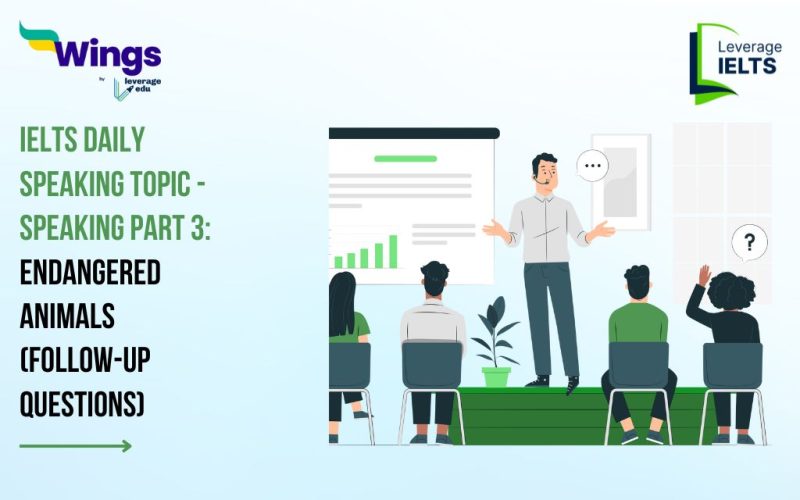Discussion Topics
- Causes of Endangerment
- Conservation Efforts
- Public Awareness
Follow-up Questions
1. Causes of Endangerment
Q.1. What are the main causes of the endangerment of animals?
Ans. I think multiple factors put animals’ lives in danger. First off, people mess with their homes by turning natural spaces into farms or cities, leaving them with nowhere to live or find food. Climate change adds to the chaos, messing up their habitats and making it super hard for animals to hang on in their usual spots. Pollution is like the ultimate enemy – it ruins their water and food, making animals sick or even killing them. To make matters worse, when people go hunting for food, for fun, or to sell animals, it messes up their numbers in a major way.
Q.2. What do you think about the role of invasive species in animal endangerment?
Ans. In my view, invasive species deteriorate our local wildlife, putting them in danger. When these outsiders start multiplying like crazy, they end up outnumbering our home team, creating a battle for food and space. They have the potential to even wipe out our native species. They bring in new diseases that our local animals aren’t ready to handle, making things even worse for them. On top of all that, these troublemakers change up our usual living spaces, making it tough for the native species to survive.
2. Conservation Efforts
Q.1 What are some of the conservation strategies that are used to protect endangered animals?
Ans. I have come across a few methods which are being employed to help the animal populace survive. One essential move is creating safe spots like national parks or wildlife reserves which keep the wildlife away from all the chaos caused by us humans. Then there are rules in place that say “hands-off” when it comes to hunting, trading, or grabbing animals. Other than that breeding programs are also carried out in zoos to increase their population. Lastly, spreading the word through education has been a game-changer. It’s like shouting from the rooftops about the struggles our endangered buddies are facing, getting everyone on board to help out.
Q.2. What role do zoos and aquariums play in animal conservation?
Ans. I believe zoos and aquariums really step up when it comes to taking care of animals. They provide a safe home for them and run breeding programs to boost their numbers. But it’s not just about having them there – these places do a lot of research to understand the animals better and figure out how to protect them. Plus, they’re like animal ambassadors, educating the public on conservation. The best part is some even join in on reintroduction programs, breeding animals in captivity and then letting them loose back into the wild. Overall, I feel zoos and aquariums significantly assist in conserving various species of plants and animals.
3. Public Awareness
Q.1. Why is public awareness important for animal conservation?
Ans. Making sure everyone knows about what’s going on with wildlife is a big deal. When people get information on the challenges of endangered animals and why biodiversity is crucial, they tend to start making choices that help out the whole wildlife crew. It’s like everyone becomes part of the wildlife-saving squad. But here’s what’s interesting, it’s not just regular folks, but even the big shots in charge pay attention. When more people care, it kind of pushes the bigwigs to make better rules for protection. Like, back in Delhi, people started chatting more about the local birds, and it pushed the city to step up and lay down some stronger rules to keep those winged buddies safe.
Q.2. How can one increase public awareness about animal conservation?
Ans. Certainly! There are several ways to boost public awareness about animal conservation, and education is a key player. You can kick things off in schools, backed by public outreach programs and media campaigns. Social media is another powerful tool to share information and get people thinking about the issue. I have often come across Facebook groups and pages dedicated to animal welfare which have gained traction, creating a platform where people could share information, report cases of mistreatment, and mobilize for the protection of these animals. Also, events like wildlife festivals or conservation-themed exhibitions play a crucial role in engaging the public and spreading awareness. For example, last year there was this fantastic wildlife festival in Delhi that got people talking and thinking more about animal conservation.
Are you preparing for IELTS? Check out this video to improve your speaking skills for the IELTS exam given below👇.
Download the Leverage IELTS App today.


Need help to prepare for IELTS? Check out the best IELTS preparation courses in the market offered in a live training environment by trusted educators. If you want help studying abroad, call 1800-572-130.
 One app for all your study abroad needs
One app for all your study abroad needs















 60,000+ students trusted us with their dreams. Take the first step today!
60,000+ students trusted us with their dreams. Take the first step today!